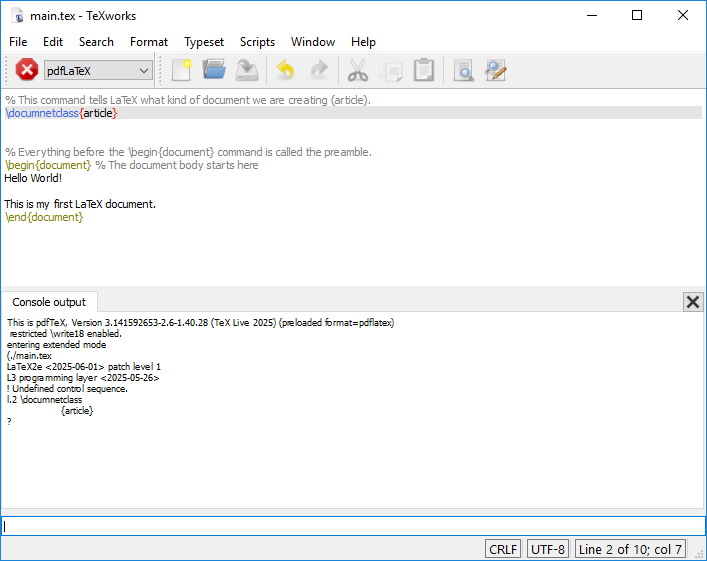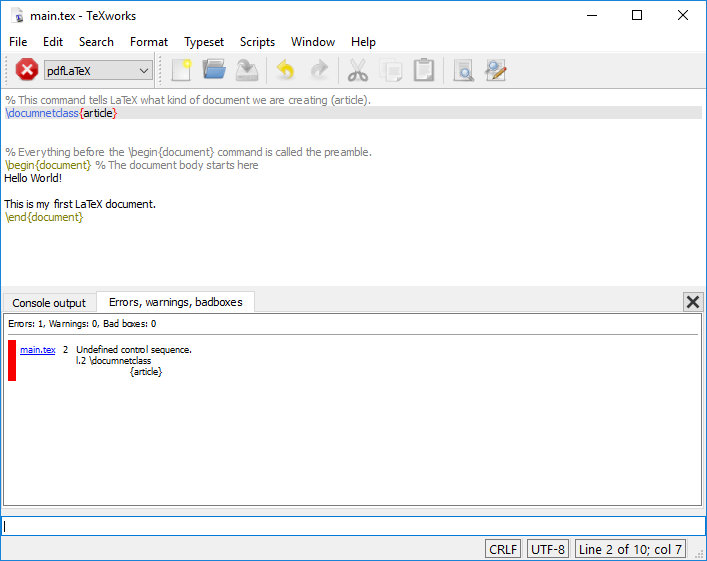Error Handling
Last updated on 2025-07-03 | Edit this page
Overview
Questions
- What do I do when I get an error message?
Objectives
- Understand how to interpret error messages in LaTeX
- Learn how to fix common errors in LaTeX documents
Error Handling
Error messages in LaTeX can often be difficult to understand, especially if you’re new to the language. However there are a few common errors that we can learn to recognize and fix, and a few techniques we can use to debug our documents based on the error messages we receive.
Inevitably, everyone makes mistakes when writing LaTeX documents. When you recompile your document, you might not see any changes in the preview pane. This could be because there is an error in your document. If there is an error, you will see a red number next to the “Recompile” button over the “Logs and output files” button. You will also see certain lines highlighted in red in the text editor, along with a suggestion of what the error might be.
Let’s introduce an error into our project to see what this might look
like. Let’s introduce a typo into the documentclass command
by changing it to documnetclass. When we recompile the
document, we can see our errors:
LATEX
% This command is misspelled on purpose to generate an error
\documnetclass{article}
\begin{document}
Hello World!
This is my first LaTeX document.
\end{document}Commands in the console:
- Type
to proceed, - S to scroll future error messages,
- R to run without stopping
- Q to run quietly,
- I to insert something
- E to edit your file
- 1 or … or 9 to ignore the next 1 to 9 tokens of input,
- H for help
- X to quit
Fixing Errors
In general, the first error message you see is the most important one
to fix. In this case, all of the subsequent errors are related to the
initial error, which is that the \documentclass command is
undefined. Once we fix the typo in the \documentclass
command, the document will compile successfully.
The subsequent errors, talking about “missing begin document”, and “font size command not defined” are all cascading errors from the initial error. When LaTeX encounters an error, it can’t continue to compile the document, so it stops and reports the error it found. This can sometimes lead to multiple error messages, but generally it’s important to fix the first error first, as this will often resolve subsequent errors.
Anatomy of an Error Message
Let’s take a closer look at one of them and see what it tells us.
! Undefined control sequence.
l.2 \documnetclass
{article}This message tells us a few things: 1.
! Undefined control sequence.: This indicates that LaTeX
encountered a command that it doesn’t recognize. In this case, it’s the
misspelled \documnetclass command. 2. l.2:
This tells us that the error occurred on line 2 of the document. 3.
\documnetclass: This is the command that caused the error.
LaTeX doesn’t recognize this command because it is misspelled.
Of course, we know what the error was, so we can just fix it by
changing \documnetclass back to
\documentclass.
In general, the first error message in the list is the most useful one to look at. The other error messages are often just a result of the first error cascading down the document, so fixing the first one will often fix the rest of them too.
Common Errors
Let’s take a look at some common errors you might encounter when working with LaTeX.
Unidentified Control Sequence
We saw this one in our first example, but it can happen any where there is a command that LaTeX doesn’t recognize. This can happen if you misspell a command, or if you forget to include a package that defines the command, of if you try to use an incorrect command.
Here’s a quick example of this error:
LATEX
\documentclass{article}
\begin{document}
My Amazing Content: $\alpha = \fraction{1}{(1 - \beta)^2}$
\end{document}Attempting to compile this document results in the following error message:
! Undefined control sequence.
l.5 My Amazing Content: $\alpha = \fraction
{1}{(1 - \beta)^2}$So, again, we see that the error is an “Undefined control sequence”,
and it tells us that something in line 5 is not defined. In this case,
the command \fraction is not a valid LaTeX command.
File Not Found
Here’s another LaTeX excerpt:
LATEX
\documentclass{article}
\usepackage{booktab}
\begin{document}
More Amazing Content!
\end{document}The following error message appears when you try to compile this document:
! LaTeX Error: File `booktab.sty' not found.This error indicates that LaTeX is unable to find the
booktab package. The correct package name should be
booktabs.
Overfull Boxes
The following code generates a warning message:
LATEX
\documentclass{article}
\usepackage{graphicx}
\begin{document}
\section{Adding a rotated image}
We can rotate an image by setting the "angle" parameter:
\includegraphics[scale=2, angle=45]{example-image}
\end{document}The document compiles successfully, but there was some text that briefly appeared in the console output. Let’s look at the .log file to see what it says:
Overfull \hbox (390.7431pt too wide) in paragraph at lines 10--11
[][]
[]
[1
{c:/texlive/2025/texmf-var/fonts/map/pdftex/updmap/pdftex.map}]
Overfull \vbox (170.7431pt too high) has occurred while \output is active []
[2 <./example-image.png>] (./main.aux)This message indicates that there is an “overfull hbox” and “overfull vbox”. This means that the text or image is too wide or too tall for the page, and it is overflowing into the margins. This is a common issue when including images in LaTeX.
Errors vs Warnings vs Information
Not all messages are equal! LaTeX has three different types of messages:
-
Error: This is a serious issue that will prevent your document from compiling. You need to fix this before you can continue. -
Warning: This is a less serious issue that may not prevent your document from compiling, but it may cause issues with the output. You should still try to fix this, but it may not be critical. -
Information: This is just a message that provides additional information about the document. You can usually ignore this.
In Overleaf, error messages are shown in red, warnings are shown in yellow, and information messages in blue.
Challenges
Challenge 1: Why do I get this warning?
PLACEHOLDER
PLACEHOLDER
- Errors are common! Don’t be discouraged by them.
- The first error message is usually the most important one to fix.
- Read the error messages carefully, they often tell you exactly what the problem is.



